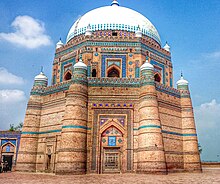| Shah Rukn-e-Alam شاہ رکن عالم | |
|---|---|
 The shrine of Rukn-e-Alam in Multan The shrine of Rukn-e-Alam in Multan | |
| Personal life | |
| Born | 26 November 1251 Multan, Punjab (present-day Punjab, Pakistan) |
| Died | 3 January 1335(1335-01-03) (aged 83) Multan, Punjab (present-day Punjab, Pakistan) |
| Religious life | |
| Religion | Sunni Islam |
| Senior posting | |
| Based in | Multan, Punjab |
| Period in office | 13th and 14th century |
| Part of a series on Islam Sufism |
|---|
 |
| Ideas |
| Practices |
Sufi orders
|
| List of sufis |
| Topics in Sufism |
|
|
Sheikh Rukn-ud-Din Abul Fateh (Punjabi: شیخ رکن الدین ابوالفتح; 26 November 1251 – 3 January 1335), commonly known by the title Shah Rukn-e-Alam ("Pillar of the World"), was an eminent 13th and 14th-century Punjabi Muslim Sufi saint from Multan (present-day Punjab, Pakistan), who belonged to Suhrawardiyya Sufi order. His shrine in Multan, is one of Punjab's most important places of historical and cultural value.
Biography
Shah Rukne Alam was the son of Pir Sadar-Al-Din Arif. He was born in Multan on 26 November 1251 and died 3 January 1335. He was the grandson and successor of Sheikh Baha-ud-din Zakariya. He was buried in the mausoleum of his grandfather, according to his own will, but later, his coffin was transferred to the present mausoleum. Shah Rukn-e-Alam conferred his spiritual succession on Sufi sheikh Sultan Ul Tareeqin Sheikh Hameed ud Din Shah Hakim Al-Qureshi Asadi Al-Hashmi Suhrawardi. He is buried at Mau Mubarak in Rahim Yar Khan. He was Shah Rukn e Alam's Ataleeq-e-Awwal, Khalifa-e-Awwal and was married to the daughter of Sheikh Baha-ud-Din Zakariya.
Mausoleum
Main article: Tomb of Shah Rukn-e-AlamThe saint is still revered today and his tomb is the focus of the pilgrimage of over 100,000 pilgrims yearly from all over South Asia. Shah Mehmood Qureshi is the current Sajjada Nashin and custodian of the Mausoleum of Shah Rukn-e-Alam.
The tomb was built between 1320 and 1324 CE in the pre-Mughal architectural style. The tomb is said to have built by Ghias-ud-Din Tughlak (r.1320-1325 AD) during his governorship of Depalpur, between 1320 and 1324 CE and was given by his son, Muhammad bin Tughluq to the descendants of Shah Rukn-e-Alam for the latter's burial in 1330. In the 1970s, the mausoleum was thoroughly repaired and renovated by the Auqaf Department. The entire glittering glazed interior is the result of new tiles and brickwork done by the Kashigars of Multan.
This tomb is on the tentative list as a UNESCO World Heritage Site.
Memorandum
- Shah Rukan e Alam, named after the saint, is one of the autonomous towns of the city of Multan.
- A daily train service, Shah Rukn-e-Alam Express, between Multan and Karachi was named after him. It was suspended in February 2011 due to lack of locomotives.
See also
References
- ^ "Urs celebrations of sufi saint Shah Rukn-e-Alam underway". Pakistan Today (newspaper). 23 January 2018. Retrieved 20 March 2021.
- ^ History of Multan (scroll down to read The Tomb Of Shah Rukn-e-Alam) Government of Pakistan website, Retrieved 18 March 2021
- ^ Over 100,000 pilgrims yearly as visitors UNESCO World Heritage website, Published 30 January 2004, Retrieved 20 March 2021
- More trains may be suspended Dawn (newspaper), Published 2 February 2011, Retrieved 18 March 2021